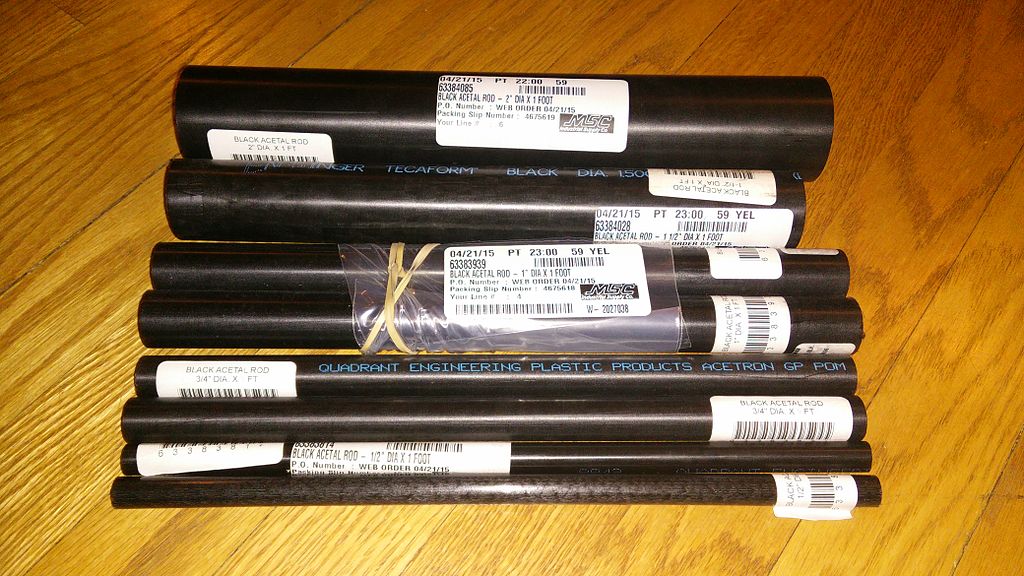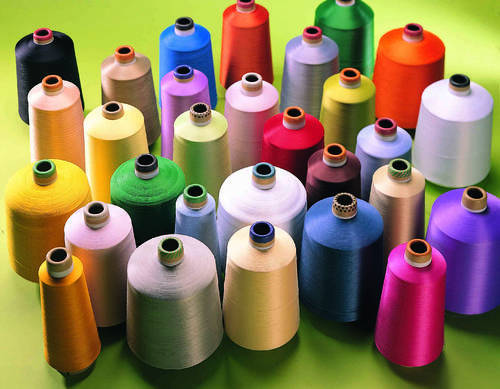The key difference between Delrin and nylon is that Delrin is a thermoplastic made from polyoxymethylene, whereas nylon is a thermoplastic made from the reaction between an amide and dicarboxylic acid.
Delrin is the trade name for the polymer material polyoxymethylene or POM. Nylon is a type of polyamide that is synthetic.
CONTENTS
1. Overview and Key Difference
2. What is Delrin
3. What is Nylon
4. Delrin vs Nylon in Tabular Form
5. Summary – Delrin vs Nylon
What is Delrin?
Delrin is the trade name for the polymer material polyoxymethylene or POM. It is also known as acetal, polyacetal, or polyformaldehyde in polymer chemistry. It is a type of engineering thermoplastic material that is useful in precision parts requiring high stiffness, low friction, and excellent dimensional stability. Delrin is also a type of synthetic polymer material. This material is produced by different chemical firms with slightly different formulas, and these are sold using different names, including Delrin, Kocetal, Ultraform, Celcon, etc.

High strength, hardness, and rigidity at very low temperatures are the characteristic features of Derlin. Intrinsically, this material is opaque white due to its high crystalline composition. However, it is available in different colors as well on a commercial scale.
When considering the production of Delrin, we can produce it in the form of a homopolymer or in the form of a copolymer. We can produce the homopolymer by the reaction of the aqueous formaldehyde with an alcohol to create a hemiformal, dehydration of the hemiformal/water mixture, followed by the release of the formaldehyde by heating the hemiformal. Thereafter, the hemiformal is polymerized through anionic catalysis to get the desired product.
What is Nylon?
Nylon is a type of polyamide that is synthetic. It is a group of polymers that include plastics. We can name these polymers as thermoplastic materials because of their thermal properties. Some of the members of this group include nylon 6. Nylon 6,6, nylon 6.8. etc.
This polymer type belongs to the condensation polymer group because of the method of synthesis. Nylon material is made by condensation polymerization. Here, the monomers used in the production of nylon are diamines and dicarboxylic acids. The condensation polymerization of these two monomers forms peptide bonds. A water molecule is produced per each peptide bond as a byproduct.

Most of the nylon forms are composed of symmetrical backbones and are semi-crystalline. This makes nylons very good fibers. The name of the form of nylon is given according to the number of carbon atoms present in the diamine and dicarboxylic acid monomers. For example, in nylon 6,6, there are six carbon atoms in the dicarboxylic acid and six carbon atoms in the diamine.
Generally, nylons are tough materials. This material has good chemical and thermal resistance. Nylons can be used in high-temperature environments. The maximum temperature where nylon can be used is at 185°C. The glass transition temperature of nylon is about 45°C. The glass transition temperature of a polymer is the temperature at which the polymer transitions from a hard, glassy material to a soft, rubbery material.
What is the Difference Between Delrin and Nylon?
Delrin and nylon are important thermoplastic polymer materials. The key difference between Delrin and nylon is that Delrin is a thermoplastic made from polyoxymethylene, whereas is a thermoplastic made from the reaction between an amide and dicarboxylic acid. Moreover, Delrin is important in the manufacture of pumps, valve components, gears, bearings, bushings, rollers, fittings, etc., while nylon is useful in clothing, and reinforcement in rubber substances such as car tiers, as a rope, as a thread, etc.
The below infographic presents the differences between Delrin and nylon in tabular form for side by side comparison.
Summary – Delrin vs Nylon
Delrin is the trade name for the polymer material polyoxymethylene or POM. Nylon is a type of polyamide that is synthetic. The key difference between Delrin and nylon is that Delrin is a thermoplastic made from polyoxymethylene, whereas nylon is a thermoplastic made from the reaction between an amide and dicarboxylic acid.
Reference:
1. “Delrin Plastic Material Properties.” Protolabs.
Image Courtesy:
1. “South Bend Lathe Delrin stock for machining (17051720658)” By Nathanael Burton – Delrin stock for machining (CC BY-SA 2.0) via Commons Wikimedia
2. “Nylon 66” By José Bruno Silva Gomes – Own work (CC BY-SA 4.0) via Commons Wikimedia
ncG1vNJzZmivp6x7pbXFn5yrnZ6YsqOx07CcnqZemLyue9ahmK1lmah6tbTEZpuinpaav6a6wp5km52krLKmuoydnKWqmaN6orrDZqWypJ%2BjfA%3D%3D